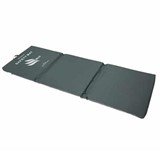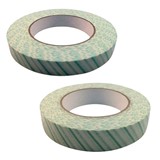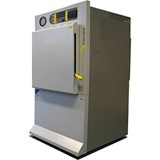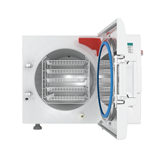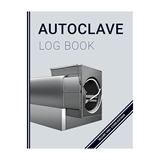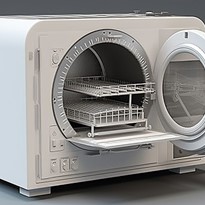Dental autoclaves are vital devices in ensuring the proper sterilization of instruments and equipment in dental practices. To ensure their effective operation, it is important to follow a step-by-step guide for their operation, maintenance, and safety. This guide will outline the necessary steps to ensure the proper use of dental autoclaves and maintain a safe working environment.
- Read the Manufacturer's Instructions: Before operating a dental autoclave, carefully read and understand the manufacturer's instructions provided in the user manual. Familiarize yourself with the specific features, controls, and operating procedures of the autoclave model you are using.
- Prepare the Instruments: Properly prepare the instruments for sterilization. Remove any debris or organic matter from the instruments and place them in autoclave-safe bags or pouches. Ensure that the instruments are arranged in a way that allows proper steam penetration.
- Load the Autoclave: Load the prepared instruments into the autoclave chamber, making sure not to overload or overcrowd the chamber. Proper spacing between the instruments allows for effective steam circulation and ensures thorough sterilization.
- Add Water: Fill the autoclave's water reservoir with distilled or demineralized water, following the manufacturer's instructions. The water level should be sufficient to generate the necessary steam during the sterilization process.
- Select the Sterilization Cycle: Choose the appropriate sterilization cycle based on the type of instruments and materials being sterilized. Common cycles include standard cycles, quick cycles, or specialty cycles for specific instruments or materials. Refer to the autoclave manual for guidance on cycle selection.
- Start the Sterilization Process: Close the autoclave chamber door securely and start the sterilization process by following the instructions provided. Ensure that the autoclave reaches the required temperature and pressure levels for effective sterilization.
- Monitor the Cycle: During the sterilization cycle, closely monitor the autoclave to ensure that it operates smoothly. Pay attention to any error messages or indicators that may appear on the control panel. If any issues arise, consult the manufacturer's instructions or contact technical support.
- Complete the Cycle: Once the sterilization cycle is complete, allow the autoclave to release the pressure and temperature before opening the chamber. Follow the manufacturer's instructions on the appropriate waiting time for the autoclave to cool down.
- Unload and Store Sterilized Instruments: Carefully remove the sterilized instruments from the autoclave chamber, taking precautions to avoid burns or injuries. Place the instruments in a designated clean area or storage cabinet to maintain their sterility until they are ready for use.
Maintenance and Safety:
- Regular Cleaning: After each use, clean the autoclave chamber and trays according to the manufacturer's instructions. Remove any residue or deposits to prevent build-up and ensure optimal performance.
- Routine Maintenance: Follow the recommended maintenance schedule provided by the manufacturer. This may include tasks such as replacing filters, checking seals, and lubricating moving parts. Adhering to the maintenance schedule helps prolong the lifespan of the autoclave and ensures its continued effectiveness.
- Calibration and Validation: Periodically calibrate and validate the autoclave to ensure accurate temperature and pressure readings. This can be done by a qualified technician or following the manufacturer's guidelines. Calibration and validation help maintain the autoclave's reliability and accuracy.
- Safety Precautions: Adhere to safety precautions when operating the dental autoclave. Use personal protective equipment, such as gloves and protective eyewear, to protect yourself from potential hazards. Follow proper handling techniques to avoid accidents and injuries.
- Staff Training: Provide comprehensive training to dental staff members on the proper operation and safety procedures of the autoclave. Ensure that all staff members are familiar with the autoclave's operation, maintenance, and safety protocols. This includes training on loading and unloading instruments, selecting the appropriate sterilization cycles, and following safety guidelines. Regularly reinforce training to ensure staff members are up to date with best practices and safety measures.
- Documentation and Record-Keeping: Maintain accurate records of each sterilization cycle, including the date, time, cycle parameters, and the instruments sterilized. This documentation serves as a reference for quality control and compliance with regulatory standards. Keep a log of maintenance activities, such as filter replacements and calibration, to track the autoclave's performance and ensure timely maintenance.
- Compliance with Regulations: Stay informed about the regulatory requirements and guidelines related to dental autoclave operation, maintenance, and safety. Ensure that your practice complies with applicable standards and regulations set by regulatory bodies, such as the FDA or local health authorities.
- Emergency Procedures: Familiarize yourself and your staff with emergency procedures in case of power outages, equipment malfunctions, or other unforeseen circumstances. Establish protocols for safely handling emergencies to minimize risks to staff and patients.
- Ongoing Quality Assurance: Implement a quality assurance program to regularly evaluate the effectiveness of the autoclave's sterilization processes. This may include periodic spore testing to verify the autoclave's ability to eliminate microbial contaminants. Monitor and review the results to identify any deviations or issues that require corrective action.


Find the right Dental Autoclave
Compare quotes from expert Australian suppliers and make the best choice. It's free, quick and easy!
Dental Autoclave Safety Features and Precautions
Dental autoclaves are essential for ensuring the sterilization of instruments and maintaining a safe dental practice environment. To further enhance safety measures, modern dental autoclaves come equipped with various safety features and precautions. Understanding and utilizing these features is crucial to prevent accidents, protect staff and patients, and ensure efficient and effective sterilization. Here are some common safety features and precautions associated with dental autoclaves:
- Pressure and Temperature Monitoring: Dental autoclaves have built-in sensors that continuously monitor the pressure and temperature inside the chamber. These sensors ensure that the autoclave operates within safe and optimal ranges. If the pressure or temperature exceeds the set limits, the autoclave will automatically adjust or stop the cycle to prevent any potential risks.
- Safety Interlocks: Autoclaves are equipped with safety interlocks, which are mechanisms that prevent the door from being opened during a sterilization cycle or when the chamber is still pressurized. This feature ensures that operators cannot access the chamber until it is safe to do so, reducing the risk of exposure to high temperatures or steam.
- Overpressure Protection: In the event of excessive pressure build-up, dental autoclaves are designed with overpressure protection mechanisms. These mechanisms release the excess pressure through pressure relief valves or vents, preventing any potential damage to the autoclave or compromising the safety of the surrounding environment.
- Alarms and Indicators: Dental autoclaves are equipped with audible and visual alarms to alert operators of any abnormalities or deviations during the sterilization process. These alarms can indicate issues such as low water levels, door not properly sealed, or cycle failure. Prompt notifications allow operators to take immediate action and prevent potential hazards.
- Emergency Stop Button: Autoclaves are fitted with emergency stop buttons that enable operators to halt the sterilization cycle in case of an emergency or abnormal situation. This feature provides a quick and convenient way to interrupt the cycle and address any unforeseen circumstances.
- Insulation and Cool-Down Periods: Dental autoclaves are designed with effective insulation to minimize heat transfer to the external surfaces, reducing the risk of burns or injuries. Additionally, autoclaves typically have cool-down periods after the sterilization cycle is complete to allow the chamber and instruments to cool down gradually before the door can be safely opened.
- Operator Training: Proper training of dental staff on autoclave safety is vital. All operators should receive comprehensive training on the safe operation of the autoclave, including understanding the safety features, following proper loading and unloading procedures, and adhering to the manufacturer's guidelines. Regular training and refresher courses will help ensure that operators are aware of the potential risks and precautions associated with dental autoclaves.
Dental Autoclave 12 Safety Precautions
Ensuring safety in dental autoclave operations is paramount to protect both the users and patients. Here are some important safety precautions to follow when using a dental autoclave:
- Personal Protective Equipment (PPE): Wear appropriate PPE, including gloves, goggles, and lab coats, to protect against potential hazards, such as heat, steam, and chemical exposure. PPE creates a barrier between the user and any potentially harmful substances.
- Read and Follow Instructions: Familiarize yourself with the manufacturer's instructions and guidelines for the specific model of the dental autoclave you are using. Follow the recommended operating procedures, load capacity, and sterilization cycles.
- Proper Loading and Unloading: Ensure proper loading of instruments and equipment into the autoclave. Arrange items in a way that allows steam to penetrate effectively and ensures even heat distribution. Avoid overcrowding to prevent inadequate sterilization.
- Check Instrument Compatibility: Verify that the instruments and materials being sterilized are suitable for autoclaving. Some items may be sensitive to heat or moisture and require alternative sterilization methods.
- Chamber Inspection: Before starting the autoclave cycle, inspect the chamber for any visible signs of damage, such as cracks or leaks. If any issues are identified, promptly notify the appropriate personnel and refrain from using the autoclave until repairs are made.
- Water Level Maintenance: Maintain the proper water level in the autoclave reservoir as specified by the manufacturer. Inadequate water levels can result in ineffective sterilization, while overfilling can cause leaks or other hazards.
- Safe Closure and Sealing: Ensure that the autoclave door is closed and sealed properly before starting the sterilization process. A secure closure prevents steam from escaping and maintains the required pressure for effective sterilization.
- Ventilation: Place the dental autoclave in a well-ventilated area to prevent the accumulation of steam and heat. Proper ventilation helps maintain a comfortable working environment and reduces the risk of burns or overheating.
- Pressure Release: Allow the autoclave to complete the full sterilization cycle before attempting to open the door. Follow the manufacturer's instructions for the safe release of pressure. Never force open the door while the autoclave is pressurized, as it can lead to steam burns or other injuries.
- Cool-Down Period: After the sterilization cycle is complete, allow the items and the autoclave chamber to cool down before opening the door. Opening the door prematurely can result in burns from hot steam or items.
- Regular Maintenance and Servicing: Schedule regular maintenance and servicing of the dental autoclave as recommended by the manufacturer. Follow proper cleaning procedures and ensure the autoclave is inspected for any issues that may compromise its safety or performance.
- Operator Training: Provide comprehensive training to all staff members who will be operating the dental autoclave. Ensure they are well-versed in the safety precautions, operating procedures, emergency protocols, and maintenance requirements specific to the autoclave model being used.
Dental Autoclave Maintenance and Troubleshooting
Proper maintenance and regular troubleshooting of your autoclave are vital for its optimal performance and longevity. By implementing routine maintenance practices and addressing any issues promptly, you can ensure reliable sterilization and prevent downtime. In this article, we will discuss essential autoclave maintenance tasks and troubleshooting techniques to help you keep your autoclave in excellent working condition.
Dental Autoclave Maintenance:
To ensure the optimal performance and longevity of dental autoclaves, it is important to follow a maintenance schedule that includes regular weekly, daily, and monthly tasks. Here are some guidelines for each maintenance interval:
Daily Maintenance:
- Pre-cycle Inspection: Before starting any sterilization cycle, inspect the autoclave for any visible signs of damage, such as cracks, leaks, or loose components. Ensure that the door seal is intact and in good condition. If any issues are found, address them before proceeding with sterilization.
- Loading and Unloading: Properly load the instruments and equipment in the autoclave according to the manufacturer's instructions. Make sure that items are arranged to allow steam penetration and that the autoclave is not overloaded. After the sterilization cycle is complete, carefully unload the sterilized items, ensuring proper handling to maintain sterility.
- Post-cycle Cleaning: Clean the autoclave chamber and trays after each sterilization cycle to remove any residue or condensation. Wipe down the chamber and trays using a clean, lint-free cloth. Properly dry the chamber before the next cycle.
Weekly Maintenance:
- Chamber Cleaning: Thoroughly clean the autoclave chamber using a non-abrasive, autoclave-approved cleaner. Pay special attention to removing any residue, stains, or debris that may have accumulated. Rinse the chamber thoroughly after cleaning.
- Tray and Accessory Cleaning: Clean the trays, racks, and accessories used in the autoclave. Remove any visible dirt or contaminants and rinse them properly. Ensure that all trays and accessories are completely dry before returning them to the autoclave.
- Water Reservoir Cleaning: If your autoclave has a water reservoir, check it for mineral deposits or debris. Clean the reservoir according to the manufacturer's instructions to ensure proper water quality for steam generation.
Monthly Maintenance:
- Calibration Check: Perform a calibration check to ensure accurate temperature and pressure readings. Use appropriate calibration equipment recommended by the manufacturer and follow the calibration instructions provided. Record the calibration results for documentation purposes.
- Seal Inspection: Thoroughly inspect the door seal and gaskets for any signs of wear, damage, or deterioration. Replace the seal if necessary to maintain proper sealing during sterilization cycles.
- Filter Replacement: If your autoclave has a filtration system, check the filters and replace them as recommended by the manufacturer. Proper filtration is essential for maintaining water quality and preventing mineral buildup
- Overall Inspection: Conduct a comprehensive inspection of the autoclave, including the control panel, valves, trays, and accessories. Ensure that all components are in good working condition and that there are no loose or damaged parts. Address any issues promptly by contacting the manufacturer or a qualified technician.
Yearly Maintenance
- Professional Inspection and Service: Schedule a professional inspection and service for your dental autoclave at least once a year. Engage a qualified technician or the manufacturer's authorized service provider to thoroughly assess the autoclave's performance, safety features, and internal components. They will conduct a comprehensive examination to identify any potential issues, perform necessary repairs or adjustments, and ensure the autoclave meets regulatory requirements.
- Replacement of Wearable Parts: Some wearable parts of the autoclave may require replacement on a yearly basis to maintain optimal performance. This can include items such as door seals, gaskets, valves, filters, and other components specified by the manufacturer. Refer to the autoclave's user manual or contact the manufacturer for guidance on the recommended replacement schedule for these parts.
- Water Quality Analysis: Periodically analyze the water quality used in the autoclave's steam generation system. A yearly analysis provides an opportunity to assess the quality of water and detect any changes or issues that may impact autoclave performance. Follow the manufacturer's guidelines for water quality requirements and take necessary actions, such as implementing water treatment or filtration systems, if recommended.
- Electrical Safety Check: Conduct an electrical safety check for the autoclave. Ensure that all electrical connections and cords are in good condition without any signs of damage or wear. Check for proper grounding and test the electrical system to confirm that it meets safety standards. If any electrical issues are found, consult a professional technician for repairs or adjustments.
- Documentation Review: Review and update the documentation related to the autoclave, including maintenance records, calibration certificates, service reports, and any other relevant documentation. Ensure that all records are accurate, up to date, and easily accessible for future reference and regulatory compliance.
- Staff Training and Education: Yearly maintenance is an opportunity to provide refresher training to dental professionals who use the autoclave. Reinforce proper operating procedures, safety protocols, and maintenance practices. Stay updated on any new developments or guidelines issued by the manufacturer or regulatory authorities, and educate staff accordingly.
By following this maintenance schedule, dental professionals can ensure the reliable performance of their autoclaves and maintain a safe and hygienic dental environment. Regular cleaning, inspection, calibration checks, and component replacements, when necessary, contribute to the longevity and efficiency of the autoclave.
Dental Autoclave Troubleshooting:
Dental autoclaves are sophisticated devices that undergo regular use in busy dental practices. Occasionally, issues may arise that require troubleshooting to ensure proper functioning and effective sterilization. Understanding common problems and their solutions can help dental professionals address minor issues and maintain the optimal performance of their autoclaves. In this section, we will explore some common dental autoclave troubleshooting scenarios and their possible solutions.
-
Insufficient Sterilization:
Problem: Instruments are not adequately sterilized, and sterilization indicators do not change color or reach the appropriate mark.
Solution:
- Ensure proper loading: Overcrowding the autoclave chamber or blocking steam vents can hinder steam circulation and heat penetration. Ensure instruments are properly spaced, and steam can freely reach all items.
- Check sterilization cycle parameters: Verify that the autoclave is set to the correct sterilization cycle with the appropriate temperature, pressure, and exposure time. Adjust the cycle settings if necessary, following manufacturer guidelines.
- Check water level: Insufficient water can affect steam generation and pressure. Refill the water reservoir as needed, following the autoclave's instructions.
- Verify proper door sealing: Check the door gasket or seal for any damage or debris that may hinder a secure seal. Replace the gasket if necessary.
-
Autoclave Not Powering On:
Problem: The autoclave does not turn on or respond when the power button is pressed.
Solution:
- Check power supply: Ensure that the autoclave is properly plugged into a functioning power outlet. Check the power cord for any damage or lose connections.
- Reset or restart: Some autoclaves may have a reset or restart function. Try resetting or restarting the autoclave according to the manufacturer's instructions.
- Check circuit breaker or fuse: If the power outlet is working, check the circuit breaker or fuse box to ensure that the circuit supplying power to the autoclave has not tripped or blown a fuse. Reset or replace the circuit breaker or fuse as needed.
-
Water Leakage:
Problem: Water leaks from the autoclave during operation or when filling the water reservoir.
Solution:
- Check the water reservoir: Ensure that the water reservoir is properly seated and tightly secured. Inspect the reservoir for any cracks or damage that may cause leakage. Replace the reservoir if necessary.
- Check water filling procedure: Follow the manufacturer's instructions for filling the water reservoir. Avoid overfilling or spilling water, as this can lead to leakage. Use a funnel if necessary to prevent spills.
- Inspect tubing and connections: Examine the water tubing and connections for any loose or damaged parts. Tighten or replace any faulty components as needed.
-
Error Messages or Alarms:
Problem: The autoclave displays error messages or emits alarms during operation.
Solution:
- Consult the user manual: Refer to the user manual or manufacturer's documentation for a list of error messages or alarm codes. Follow the recommended troubleshooting steps provided by the manufacturer.
- Contact technical support: If the error persists or if the issue is beyond your troubleshooting capabilities, contact the autoclave manufacturer's technical support for further assistance. Provide them with specific details of the error message or alarm code.
-
Slow Cycle or Long Sterilization Time:
Problem: The sterilization cycle takes longer than usual or seems to be running slowly.
Solution:
- Check water level: Ensure that the autoclave has an adequate water level. Insufficient water can lead to a slower cycle. Refill the water reservoir if needed.
- Clean the autoclave: Over time, mineral deposits or debris can accumulate inside the autoclave, affecting its performance. Follow the manufacturer's instructions for cleaning and descaling the autoclave regularly.
- Perform maintenance: Check if the autoclave s mainainening porerly.
-
Noisy Operation:
Problem: The autoclave produces unusual or excessive noise during operation.
Solution:
- Check for loose components: Inspect the autoclave for any loose parts or accessories that may be causing the noise. Tighten or secure any loose components.
- Verify proper installation: Ensure that the autoclave is properly installed on a stable surface and that all connections are secure. Unstable positioning or loose connections can contribute to noise.
- Clean the autoclave: Accumulated debris or mineral deposits can cause noise. Clean the autoclave, especially the chamber and internal components, following the manufacturer's instructions.
-
Calibration Issues:
Problem: The autoclave displays incorrect temperature or pressure readings
Solution:
- Verify calibration requirements: Consult the manufacturer's guidelines to understand the calibration process and frequency recommended for your autoclave model.
- Contact technical support: If you suspect calibration issues, reach out to the manufacturer's technical support for guidance on calibration procedures or to schedule calibration services.
In conclusion, mastering dental autoclave maintenance is crucial for ensuring effective sterilization and maintaining a safe dental practice environment. By following a comprehensive guide that includes proper operation, regular maintenance, adherence to safety precautions, staff training, and documentation, dental professionals can maximize the performance and longevity of their autoclaves. Understanding the safety features and precautions associated with these devices further enhances safety measures. By addressing any issues promptly through troubleshooting techniques, dental professionals can ensure reliable sterilization and minimize downtime. With a focus on maintenance, safety, and ongoing quality assurance, dental autoclaves can play a vital role in maintaining a hygienic and safe dental practice for the well-being of both staff and patients.




